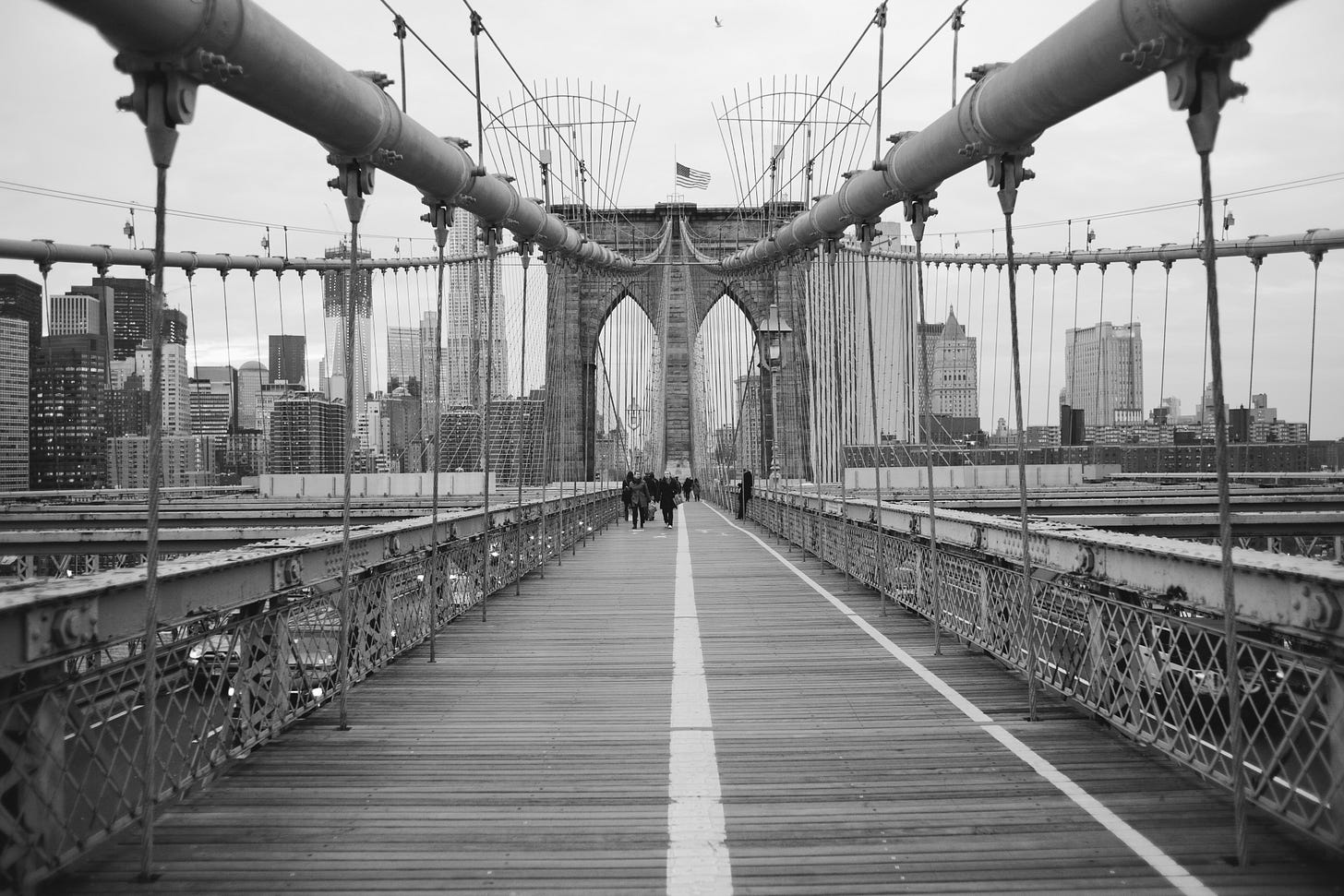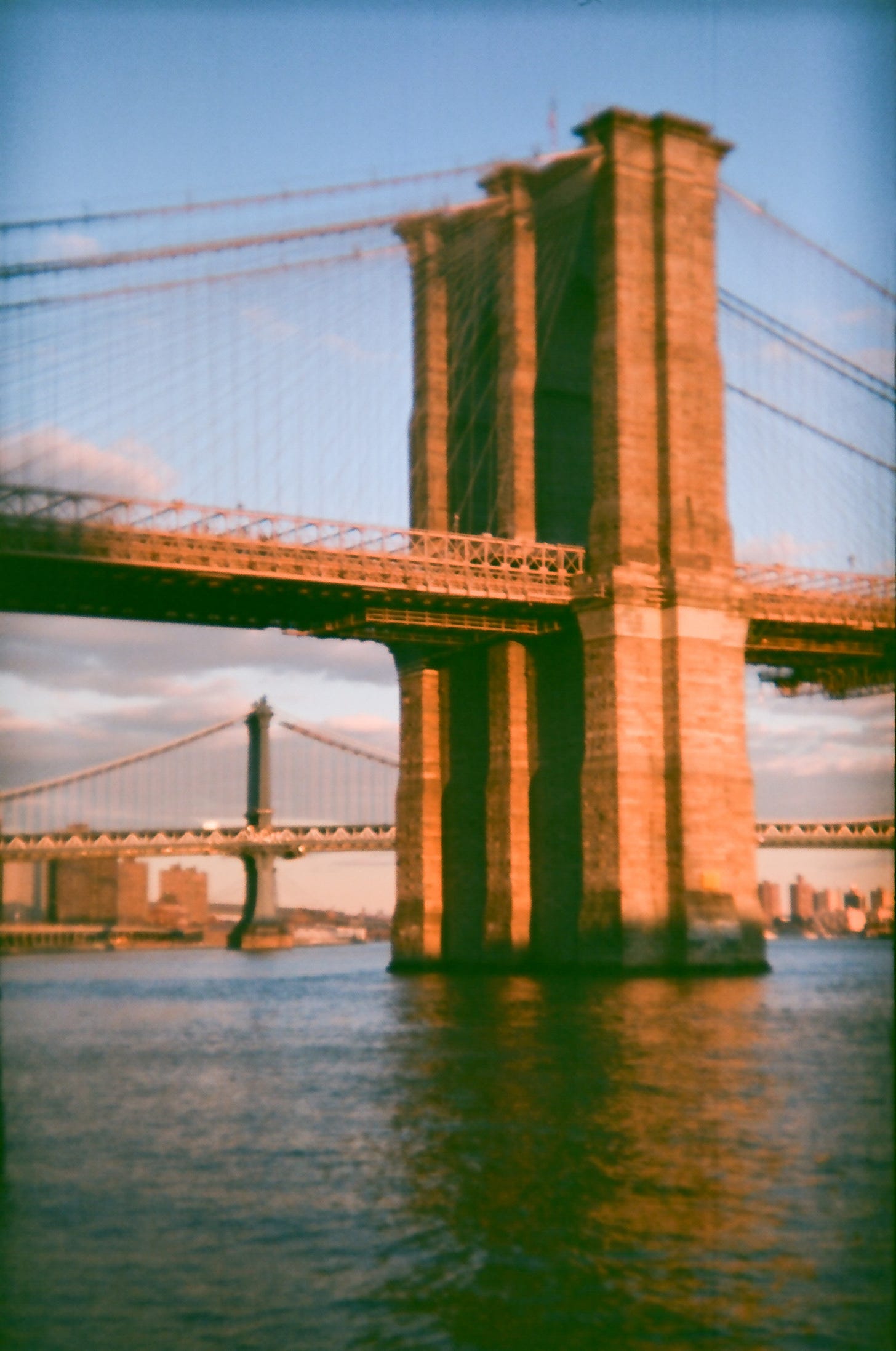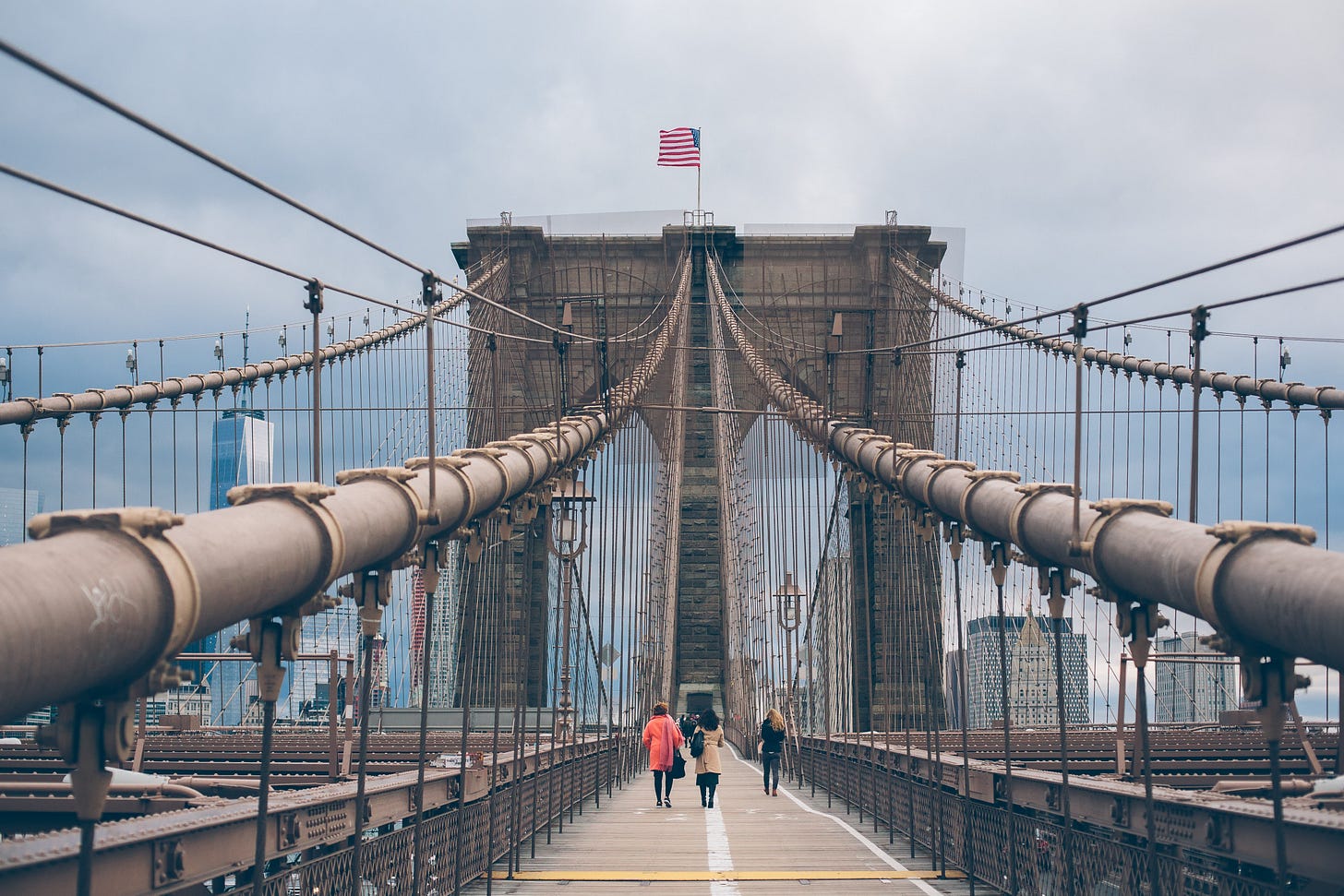Ladies and gentlemen! Cads and crooks! Children of all ages! Welcome to another world! Where beauty walks with danger! Where the impossible is commonplace! And where nothing is quite what you expect... (Barnum concludes by throwing his head back, arms wide) Welcome... To the Greatest Show on Earth!”
- The Greatest Showman
With a deck of 127 feet above mean high water, 127 years after it officially opened, I turned 50 and fulfilled my dream of walking the sturdy planks of The Great Bridge.
A main span of 1,595.5 feet, the Brooklyn Bridge was the first fixed crossing of the East River and the longest suspension bridge in the world.
Opening to a literal and deadly stampede, on May 24, 1883, the span was originally called the New York and Brooklyn Bridge or the East River Bridge but was officially renamed the Brooklyn Bridge in 1915. A brilliant feat of 19th-century engineering the great bridge was an early example of a steel-wire suspension bridge, using a hybrid cable-stayed/suspension design, with both vertical and diagonal suspender cables.
Very few things stand the test of time.
An overwhelming monument to progress, the Brooklyn Bridge, with its Neo-Gothic stone towers spanning the East River… has stood the test of time. She is presently crossed, on average, by more than 116,000 vehicles, 30,000 pedestrians and 3,000 cyclists each day.
Truth, no matter how long it takes, will continually stand the test of time. Just not in our time….or our desire for timeliness. And no matter what truth is slowly being uncovered, speck by speck, or what is being built, brick by brick, there are men and women who never give up until pillars rise out of the earth to hold it up.
I can. I will.
This was the Roebling Family living in the spirit of The Age of Optimism.
Beginning as early as 1800 there were proposals for a bridge between Brooklyn and New York. At the time, ferry lines were the only form of transportation. Engineers presented various designs, such as chain or link bridges, though these were never built because of the difficulties of constructing a high enough fixed-span bridge across the busy East River. There were also proposals for tunnels under the East River, but these were too expensive.
Then along came German immigrant engineer John Augustus Roebling who proposed building a suspension bridge over the East River in 1857. This would be 26 years prior to the official opening. He had previously designed and constructed shorter suspension bridges in Delaware and Pennsylvania and the Niagara Suspension Bridge. In 1867, Roebling erected what became the John A. Roebling Suspension Bridge over the Ohio River between Cincinnati, Ohio, and Covington, Kentucky.
I think we have forgotten what true greatness is.
Do those who drive, ride, walk and march over her know about the strength infused into the bones of those who labored to build her, died for her, for them, to have such liberty? Liberty of connection, of thought, ideas, warmth and sustainability as one gazes out to the East River below. Would they know about the only tunnel built in 1892 by the East River Gas Company that still supplies gas to Manhattan today.
Or how the original gas lamps lit the way on opening day?
Or how the year prior, in 1882, Thomas A. Edison and Edison Electric Illuminating Company of New York would flip a switch, lighting the city for the first time… while today we take for granted the glittery skyline, whose historic and modern feats of structural engineering are on show in the city that never sleeps.
…and how a man who gave us light, literally and figuratively paving the way out of darkness, would also give us the electric chair… and in a charade of horrifying circumstances, that only man could create, would send a circus elephant into electric convulsions, proving his point that alternating current (AC) was far more dangerous than direct current (DC), killing the besoden and captive animal. A fate received for having an abusive trainer.
Proving that the circus was truly a circus in a “War of Currents.”
One year after the opening, P.T. Barnum would offer to put together a demonstration to show off the Brooklyn Bridge's strength. On May 17, 1884, the world's greatest showman paraded 21 elephants and 17 camels, marching them the length from Brooklyn to Manhattan.
I can’t help but think of the Super Bowl today as I write this. In fact, that’s how this “story of eras” all came about.
Not one to partake in the viewing of professional football in a long time, mostly because, like everything else meant for old fashioned fun and “affordability,” it has been hijacked by a circus. What once took one hour to play is now three or more in what should be dubbed as “The Age of Super Bowl.”
Spectators in gold chains. Elephants captive in theirs.
On November 12, 1892, the Allegheny Athletic Association football team defeated the Pittsburgh Athletic Club. For the first time one of the AAA players, William Heffelfinger, was openly paid $500 to play the game. It took 23 years to change the original collegiate game of football, first played between Rutgers and Princeton on November 6th 1869.
Enter “The Gilded Age,” 1865 - 1902.
In the mid-1920’s, during the Progressive Age, All-America Ken Strong was at New York University, playing for the NYU Violets. He would go on to play for the New York Giants, when pro football payed $100-$300 per game. Slowly though the ways of the Gilded Age would creep back in as players competed for higher and higher salaries, jumping ship from one football team to the other vying for the biggest offer, leaving pro football in a state of chaos, rather than progression. Strong was one of the humble players.
“To gild refined gold, to paint the lily… is wasteful and ridiculous excess.”
– William ShakespeareSo would continue the era of excess. Glittering on the surface, corrupt underneath.
As the building of the Brooklyn Bridge gains momentum, here appears the bearish William "Boss” Tweed, a corrupt, powerful politician and boss to Richard B. Connelly of the infamous Tammany Hall, the seat of New York City’s Democratic Party. Some would call him"Slippery Dick,” as Connolly begins to embody the seedy political backdrop against which the bridge is constructed. Building a corrupt political machine based on patronage and graft, influence and schemes, the great bridge is a backdrop to constant obstacles and reminders of the era.
Boss Tweed’s rise into politics began in 1856 when he was elected to a new city board of supervisors. As his influence grew in New York politics, this would be the first position he would use for corrupt purposes. He once said "I don't care who does the electing, so long as I get to do the nominating."
Later, after the Brooklyn Bridge was completed, another corrupt character would come along and actually pay the price…
“…and if you believe that, I have a bridge to sell you!” Check out George C. Parker!
Sadly, John Roebling would never see the completion of the Great Bridge. His greatest. Just as construction began he would suffer a debilitating injury, leaving his young son, Washington Roebling, an imposing engineer in his own right, to ultimately oversee the completion of the bridge, along with his young wife, also an engineer, Emily Roebling. The loyalty and determination to honor his father's vision, while forging a legacy of their own was unmatched. Very few people hear of Emily’s ten year contribution to the completion while her husband Washington fell to “Caisson Disease,” a decompression syndrome also called “The Bends,” rendering him crippled and bed-ridden. Several workers were left injured or dead.

“On June 28, 1869 John and his son Washington (who was also an engineer) were surveying on a dock, when an incoming boat collided with the dock, crushing John's toes. His toes were amputated to avoid further complications and infections, however, tetanus set in and John Roebling died of lockjaw on July 22, 1869.” <National Park Service - about John Roebling>
“To construct foundations for the bridge towers, engineers sank a pair of watertight wood-and-steel chambers, called caissons, face down into the East River. Working with shovels and even dynamite to excavate the riverbed, so-called “sandhogs” toiled in stifling heat and at more than double the normal atmospheric pressure due to the compressed air pumped in to keep water out and allow workers to breathe.” <History Channel - 14 years to build and the lives it took>
I have walked streets and seen the name Roebling faded on brick, looked at Galloway’s images, strolled past a corrupt politician’s “courthouse,” name embossed in gold, doing a double-take, and walked over and under the Brooklyn Bridge several times, marveling at every detail.
During the time that Ken Strong was deciding what he would do after college, Ewing Galloway, journalist and photo editor, was building the largest photography agency in the United States, focused on the economy and transportation. A different, yet similar sort of visionary as John Roebling, both men would leave an indelible mark on a nation.
So many of the world’s best known transportation structures and mechanisms – from the lifts in the Eiffel Tower to the ski lifts in Lake Tahoe, California – stem from a small, self-contained company in the proud town of Trenton, New Jersey.
The more layered extravaganza of pro football’s halftime would begin in 1970. Fitting that journalist Tom Wolfe would dub it as "The Me Decade." He and others noticed the main concerns of most people had shifted from issues of social and political justice in the 1960s to a more self-focus on individual well-being. I don’t think much has changed. It’s just been blended into a sort of confusing whatever feels good to yell about kind of self-care. Plus the obsession with pole dancers…
In reading the last words of “Ken Strong’s” acceptance speech (1967) into the Pro Football Hall of Fame, he said: “And in conclusion, I'd like to say that when the grand master, the architect of this universe, blows the whistle, some day in the future, and assembles this great gang out on the field up above, I don’t know if I'll be in that starting lineup, but I'll be proud to be sitting on the bench.”
In the pursuit of breathless grandeur, ingenuity, dreams, triumph, tragedy, corruption and resilience who knows what the heavenly starting lineup will look like.
“Ladies and Gentlemen, behind this big top is a place called heaven!!!
The lights dim. There is but one Spotlight. The crowd goes wild…
“What has been will be again, what has been done will be done again; there is nothing new under the sun.” - Ecclesiastes 1:9











This was most interesting, I did not know the story of how this bridge was built, thank you for sharing it. I have only visited this bridge in pictures and I really love yours that you put into the article. Thank you for all the little “tangent” links, I enjoyed reading them and finding out more. And I loved how you wove the different themes through this and the way you ended it.
Friend I was amazed. I have never been to the Great Bridge or New York. I was with a man for 23 years (most of my adult life) who didn't like water or bridges. When traveling we had to do routes that didn't have high or long bridges. Boats were completely out of the question. I love hearing the history of the bridge however. and as usual your photographers eye found some really awesome photos. Thinking about it it seems that back years ago, Building bridges, tunnels or high monuments was a risky job. Chances of falling into the construction, or falling to the ground were very common. A woman engineer! wow. Back in the 1880's practically unheard of. loved it! oxoxo